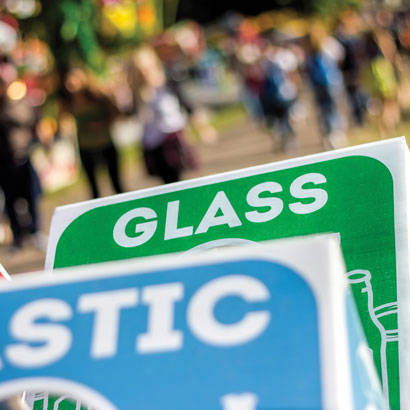
We all know that local park and recreation agencies are leaders in promoting the protection of our environment. Our agencies are essential environmental stewards, embracing practices that include the implementation of green infrastructure, conservation of public lands and protection of wildlife habitats. Just as important is the fact that local parks also reconnect people to nature through their vast precious public resources of land, water, trees, open spaces and wildlife.
Conservation and sustainability are woven throughout all facets of what it means to be a park and recreation agency. Park agencies meet the challenge of incorporating the principles of sustainability into their operations, programs and management and often do so with limited resources. The results of a recently released NRPA survey provide a greater understanding of the sustainability practices currently implemented by park agencies and of how agencies are contributing to sustainability in their communities.
| Commonly Implemented Sustainability Practices | ||
| Goal | Percent of Agencies | Sustainability Practices |
| Providing opportunities for healthy activity in nature | 81% | Increasing the accessibility to and the opportunities for walking, biking, public transit, conserving and maintaining trail systems, and establishing and promoting community gardening opportunities |
| Protecting and managing wildlife and wildlife habitats | 71% |
Controlling and managing invasive species, promoting activities that lead to the creation and conservation of habitat and managing human-wildlife interaction, while fostering human-wildlife coexistence |
| Natural land management | 70% | Planting native and regionally appropriate species, preserving/increasing tree canopy and controlling invasive plants by less toxic means |
| Reducing landfill waste | 60% |
Recycling/upcycling, recycling electronics and providing special event recycling bins and collection |
| Following environmentally friendly building practices | 56% | Using LED lighting, Energy Star-rated appliances, low-flow plumbing fixtures/water stations/water recycling and environmentally friendly cleaning supplies |
| Fostering public engagement and education | 52% | Offering environmental education opportunities; setting up educational kiosks, displays and bulletin boards in public areas; and entering public/private partnerships that promote sustainable practices |
| Implementing green infrastructure practices | 51% | Constructing rain gardens, bioswales and wetlands; conserving existing and increasing permeable surfaces; and using natural systems to reduce erosion |
While most park and recreation agencies do not have a formal sustainability plan, most execute sustainability practices with many goals in mind. The most widely cited goal is the environmental benefits that sustainable activities and practices can generate (84 percent of agencies). These benefits include improving air and water quality in the community and reducing the agency’s impact on the environment (e.g., using fuel-efficient vehicles, reducing the use of pesticides).
But, beyond the direct environmental benefits, the sustainability activities of park and recreation agencies also generate many other benefits, valued by the agency and its community, including:
- Education (69 percent)
- Cost savings (68 percent)
- Building public support (54 percent)
- Meeting the agency’s mission (53 percent)
- Regulatory obligation (32 percent)
- Public recognition (20 percent)
Park and recreation agencies meet these goals in their community through a number of widely varying sustainable practices.
Because of finite and limited access to financial and staffing resources, it is critical for park and recreation agencies to measure the impact of their sustainability practices. In all, 72 percent of park and recreation agencies have defined specific measures that gauge the success of their sustainability activities.
In the same way that sustainability goals and practices may differ by agency, so too do the measures used to capture the impact of sustainability outcomes. These measures include counting the agency’s activities, quantifying protected resources and measuring actual improvements to the environment. More specifically, top sustainability measures include:
- Quantifying increases in connections to communities and miles of trail (60 percent of agencies)
- Quantifying water usage by an agency’s parks and facilities (59 percent)
- Identifying and tracking usage of all agency electric meters (54 percent)
- Quantifying an agency’s energy usage through an audit or comparative review (48 percent)
- Quantifying the number of community members reached through education events (43 percent)
- Quantifying stormwater runoff detention, infiltration and prevention (42 percent)
- Quantifying tree canopy (42 percent)
- Counting the number of buildings with green certifications (e.g., LEED) (37 percent)
- Conducting habitat surveys (31 percent)
The implementation and promotion of sustainability practices are a natural role for park and recreation agencies. Nevertheless, most agencies face some barriers that prevent their ability to expand these efforts. These barriers may include a lack of resources, whether it be funding (61 percent) or staff dedicated to sustainability activities (40 percent) and of expertise tied to either sustainability measures (39 percent) or practices (31 percent). Far less frequently, agencies do not implement sustainability activities because the city/county political leadership, agency leadership and agency staff do not see these activities as agency priorities.
These survey findings should give park and recreation agencies a sense of pride in being part of a large network of professionals who are striving to create sustainable communities. To achieve these goals, they must employ a whole systems approach, discovering creative ways to find more resources, optimize those resources, implement sustainable practices and build community resilience. Communities are counting on their agencies to take all the necessary actions to ensure a healthy future for parks and for the planet as a whole.
Kevin Roth, Ph.D., is NRPA’s Vice President of Research.

